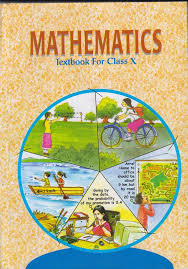Class 10 - Mathematics
Linear Equations In Two Variables - Exercise 3.5

Top Block 1
Exercise 3.5
Question : 1:Which of the following pairs of linear equations has unique solution, no solution, or infinitely many solutions.
In case there is a unique solution, find it by using cross multiplication method.
(i) x – 3y – 3 = 0 (ii) 2x + y = 5
3x – 9y – 2 = 0 3x + 2y = 8
(iii) 3x – 5y = 20 (iv) x – 3y – 7 = 0
6x – 10y = 40 3x – 3y – 15 = 0
Answer :
(i) x – 3y – 3 = 0
3x – 9y – 2 =0
a1 /a2 = 1/3
b1 /b2 = – 3/-9 = 1/3 and
c1 /c2 = – 3/-2 = 3/2
a1 /a2 = b1 /b2 ≠ c1 /c2
Therefore, the given sets of lines are parallel to each other. Therefore, they will not intersect
each other and thus, there will not be any solution for these equations.
(ii) 2x + y = 5
3x + 2y = 8
a1 /a2 = 2/3
b1 /b2 = 1/2 and
c1 /c2 = – 5/–8 = 5/8
a1 /a2 ≠ b1 /b2
Therefore, they will intersect each other at a unique point and thus, there will be a unique
solution for these equations.
By cross-multiplication method,
x/(b1 c2 – b2 c1) = y/(c1 a2 – c2 a1) = 1/(a1 b2 – a2 b1)
x/{-8–(–10)} = y/{–15 + 16} = 1/{4 – 3}
x/2 = y/1 = 1
x/2 = 1, y/1 = 1
So, x = 2, y = 1
(iii) 3x – 5y = 20
6x – 10y = 40
a1 /a2 = 3/6 = 1/2
b1 /b2 = – 5/–10 = 1/2 and
c1 /c2 = – 20/–40 = 1/2
a1 /a2 = b1 /b2 = c1 /c2
Therefore, the given sets of lines will be overlapping each other i.e., the lines will be coincident
to each other and thus, there are infinite solutions possible for these equations.
(iv) x – 3y – 7 = 0
3x – 3y – 15= 0
a1 /a2 = 1/3
b1 /b2 = – 3/–3 = 1 and
c1 /c2 = – 7/–15 = 7/15
a1 /a2 ≠ b1 /b2
Therefore, they will intersect each other at a unique point and thus, there will be a unique
solution for these equations.
By cross-multiplication,
x/{45 – (21)} = y/{–21 – (–15)} = 1/{–3 – (–9)}
x/24 = y/(–6) = 1/6
x/24 = 1/6 and y/(–6) = 1/6
x = 24/6 and y = (-6)/6
x = 4 and y = – 1
So, x = 4, y = – 1
Question : 2:(i) For which values of a and b does the following pair of linear equations have an infinite number of solutions?
2x + 3y = 7
(a – b) x + (a + b) y = 3a + b – 2
(ii) For which value of k will the following pair of linear equations have no solution?
3x + y = 1
(2k – 1) x + (k – 1) y = 2k + 1
Answer :
(i) 2x + 3y –7 = 0
(a – b)x + (a + b)y – (3a + b –2) = 0
a1 /a2 = 2/(a – b) = 1/2
b1 /b2 = – 7/(a + b) and
c1 /c2 = – 7/–(3a + b – 2) = 7/(3a + b – 2)
For infinitely many solutions, a1 /a2 = b1 /b2 = c1 /c2
2/(a – b) = 7/(3a + b – 2)
6a + 2b – 4 = 7a – 7b
a – 9b = – 4 … (i)
2/(a – b) = 3/(a + b)
2(a + b) = 3(a – b)
2a + 2b = 3a – 3b
a – 5b = 0 … (ii)
Subtracting equation (i) from (ii), we get
4b = 4
b = 1
Putting this value in equation (ii), we get
a – 5 * 1 = 0
a = 5
Hence, a = 5 and b = 1 are the values for which the given equations give infinitely many
solutions.
(ii) 3x + y –1 = 0
(2k –1)x + (k –1)y – (2k + 1) = 0
a1 /a2 = 3/(2k – 1)
b1 /b2 = 1/(k – 1) and
c1 /c2 = – 1/(–2k – 1) = 1/(2k + 1)
For no solutions,
a1 /a2 = b1 /b2 ≠ c1 /c2
3/(2k – 1) = 1/(k – 1) ≠ 1/(2k + 1)
3/(2k – 1) = 1/(k – 1)
3k – 3 = 2k – 1
k = 2
Hence, for k = 2, the given equation has no solution.
Question : 3:Solve the following pair of linear equations by the substitution and cross-multiplication methods :
8x + 5y = 9
3x + 2y = 4
Answer :
8x + 5y = 9 … (i)
3x + 2y = 4 … (ii)
From equation (ii), we get
x = (4 – 2y)/3 … (iii)
Putting this value in equation (i), we get
8{(4 – 2y)/3} + 5y = 9
32 – 16y + 15y = 27
–y = – 5
y = 5 … (iv)
Putting this value in equation (ii), we get
3x + 10 = 4
x = – 2
Hence, x = – 2, y = 5
By cross multiplication again, we get
8x + 5y – 9 = 0
3x + 2y – 4 = 0
x/{–20 – (–18)} = y/{–27 – (–32)} = 1/(16 – 15)
x/(–2) = y/5 = 1/1
x/(–2) = 1 and y/5 = 1
x = – 2 and y = 5
Mddle block 1
Question : 4:Form the pair of linear equations in the following problems and find their solutions (if they exist) by any algebraic method:
(i) A part of monthly hostel charges is fixed and the remaining depends on the number of days one has taken food in the mess.
When a student A takes food for 20 days she has to pay Rs 1000 as hostel charges whereas a student B,
who takes food for 26 days, pays Rs 1180 as hostel charges. Find the fixed charges and the cost of food per day.
(ii) A fraction becomes 1/3 when 1 is subtracted from the numerator and it becomes 1/4 when 8 is added to its denominator.
Find the fraction.
(iii) Yash scored 40 marks in a test, getting 3 marks for each right answer and losing 1 mark for each wrong answer.
Had 4 marks been awarded for each correct answer and 2 marks been deducted for each incorrect answer, then Yash would have scored 50 marks.
How many questions were there in the test?
(iv) Places A and B are 100 km apart on a highway. One car starts from A and another from B at the same time.
If the cars travel in the same direction at different speeds, they meet in 5 hours.
If they travel towards each other, they meet in 1 hour. What are the speeds of the two cars?
(v) The area of a rectangle gets reduced by 9 square units, if its length is reduced by 5 units and breadth is increased by 3 units.
If we increase the length by 3 units and the breadth by 2 units, the area increases by 67 square units. Find the dimensions of the rectangle.
Answer :
(i) Let x be the fixed charge of the food and y be the charge for food per day.
According to the question,
x + 20y = 1000 … (i)
x + 26y = 1180 … (ii)
Subtracting equation (i) from equation (ii), we get
6y = 180
y = 180/6 = 30
Putting this value in equation (i), we get
x + 20 × 30 = 1000
x = 1000 – 600
x = 400
Hence, fixed charge = Rs 400 and charge per day = Rs 30
(ii) Let the fraction be x/y
According to the question,
(x – 1)/y = 1/3
⇒ 3(x – 1) = y
⇒ 3x – y = 3… (i)
x/(y + 8) = 1/4
⇒ 4x = y + 8
⇒ 4x – y = 8 … (ii)
Subtracting equation (i) from equation (ii), we get
x = 5 … (iii)
Putting this value in equation (i), we get
15 – y = 3
y = 12
Hence, the fraction is 5/12.
(iii) Let the number of right answers and wrong answers be x and y respectively.
According to the question,
3x – y = 40 … (i)
4x – 2y = 50
⇒ 2(2x – y) = 50
⇒ 2x – y = 50/2
⇒ 2x – y = 25 … (ii)
Subtracting equation (ii) from equation (i), we get
x = 15 … (iii)
Putting this value in equation (ii), we get
30 – y = 25
y = 5
Therefore, number of right answers = 15
And number of wrong answers = 5
Total number of questions = 20
(iv) Let the speed of 1st car and 2nd car be u km/h and v km/h.
Respective speed of both cars while they are travelling in same direction = (u – v) km/h
Respective speed of both cars while they are travelling in opposite directions i.e., travelling
towards each other = (u + v) km/h
According to the question,
5(u – v) = 100
⇒ u – v = 20 … (i)
1(u + v) = 100 … (ii)
Adding both the equations, we get
2u = 120
u = 60 km/h … (iii)
Putting this value in equation (ii), we obtain
v = 40 km/h
Hence, speed of one car = 60 km/h and speed of other car = 40 km/h
(v) Let length and breadth of rectangle be x unit and y unit respectively.
Area = xy
According to the question,
(x – 5) (y + 3) = xy – 9
⇒ xy + 3x – 5y – 15 = xy – 9
⇒ 3x – 5y – 6 = 0 … (i)
(x + 3) (y + 2) = xy + 67
⇒ xy + 2x + 3y + 6 = xy + 67
⇒ 2x – 3y – 61 = 0 … (ii)
By cross multiplication, we get
x/{305 – (–18)} = y/{–12 – (–183)} = 1/{9 – (–10)}
⇒ x/(305 + 18) = y/(–12 + 183) = 1/(9 + 10)
⇒ x/323 = y/171 = 1/19
⇒ x/323 = 1/19 and y/171 = 1/19
⇒ x = 323/19 and y = 171/19
⇒ x = 17, y = 9
Hence, the length of the rectangle = 17 units and breadth of the rectangle = 9 units.

